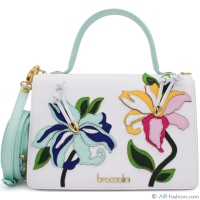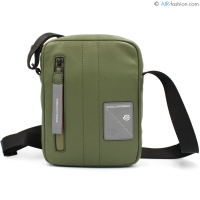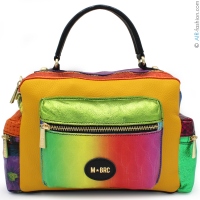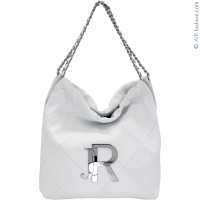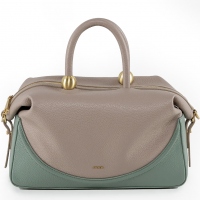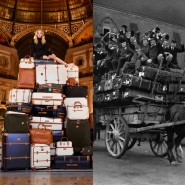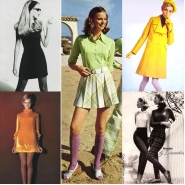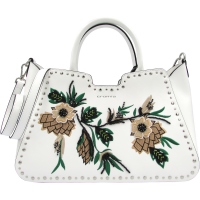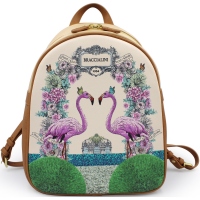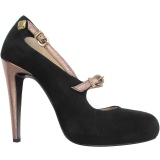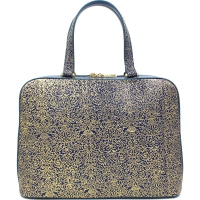Have you ever thought when and where the first bag appeared?
The Antiquity and the Middle Ages
For the first time, bags were mentioned in mythology of Ancient Greece, for example in the story about Perseus and Gorgon, as well as in the medieval literature of the 14th century. But of course the first bags appeared long time before this, when people got their first possessions and useful things that they didn’t want to leave behind travelling far from their homes. One can see bags on ancient Egyptian papyruses, antique wall carvings and frescos.

Assyrian wall carving 800-850 B.C.

Belt bag, Egypt

Clothes of ancient Greeks
Initially bags were used for practical purposes: to carry heavy things and for other housekeeping needs. Firts bags were made of leather and fur.
In the ancient world, clothes lacked such an important element as pocket. Therefore, people extensively used belt bags that were attached around their waist and used for carrying necesary items or instruments. Most common bags were made of fabric and decorated with small decorative elements. On the territory of the Eastern Europe archeologists find numerous remains of women’s leather bags dating back to the early Middle Ages. Most probab;y, these bags were made by local craftsmen. Such purses were hung on the belt or strap. They were decorated with fringes, jingles, ornamented metall onlays, embroidery and precious stones. The richer was a person, the more refined bag he or she had.

Men’s silk bag, Syria, 8 century

Byzantine Empire 9 century

Sack bag, the early Middle Ages
Pouches bags were carried by men as well: such type of bags existed all over Europe and in Scandinavian countries. On these territories, scinetists find remains of fabtic bags from the vikings’ era.

A bag purse, 819 year, was carried on the belt, found during excavations in Birka. The picture presents the original and reconstructed bag.

A bag, Spain, ealy 1300s

Bags, medieval engraving

A bag, XIV century
Among exhibits in Courtauld Gallery in London a bag was shown that resembles a modern one by its shape. This bag originated from nothern Iraq and dates from early 1300s. It was a collector Thomas Gambier Parry who brought it to England in the first half of the 19th century as an exhibit. The bag is made of silver and gold and intensively decorated with city life miniatures. The scientists have come to the conclusion that this bag a women’s item.


In the Middle Ages, the fashion for belt bags spread all over the world. For example, in Japan all small items were carried in sagemono – a recipient in the shape of a pouch or woven basket. However, inkro boxes were especially popular. They were attached to the waist with a cord: one of its ends fixed the inkro and the second one held a small figure with holes through which the cord was stretched. Such a figure - netsuke根付 was made of wood or ivory served not just a balance weight for inkro and clothes decoration, but a kind of amulet as well.



Inkro and netsuke
European bags of 16-17 centuries

A purse of goatlet leather, Belgium 16 century

A small bag, 1600 year

A velvet bag, Germany 1550-1570 years
During the Renaissance era, there was a trend among ladies to carry their bags on a special cord attached to the corset.

The portrait of the wife of the English king Henry VIII, 1545 year. Her bag hangs from the corset on an elegant cord.

Belt and corset bags, England 1625-1650 years.

Schwedler 1609 year
In the 17th century the bag forms become more complicated and turn into a real works of art: they were made of silk in the shape of a rose or a casket, decorated with various embroideries, patterns and precious stones.









Bags of 17-18 centuries
Revolution in the world of bags
France is considered to be the origin country of a modern type bag. At the end of the 18th century after the French revolution, a women’s image and fashion changed dramatically. During this very period, small bags appeared that according to the etiquette should be carried in hand. These bags were called reticules after the French name réticule.



réticule France, 1810 year

réticule France, 1820 year.

réticule France, 1820 year.

réticule England, 1930 year.
In the course of emancipation, a women’s bag gradually grew in size. If earlier it used to hold a handkerchief, a mirror and a fan, by the end of the 19th century, the contents of women’s bags were much more diversified: books, cosmetics and other useful items. Shoulder bags were introduced as well.

A small bag, England, 1880 year

A wooden bag, Scotland, the end of the XIX century

A travelling bag, France, the end of the XIX century
During the Victorian age, mass production of bags was introduced with such iconic brands created, as Hermes и Louis Vuitton.

Hermes 1935

Louis Vuitton

Gucci boutique

A Chanel bag
By the early 20th century, besides being a functional item, a bag became a garment accessory. Women started selecting bags that match shoes or a dress.
From this very period and up to now, designers have been experimenting and creating bags of various and the most incredible shapes and colors.

An umbrella bag, 1930
In the 1930s, a discoverer of surrealism in fashion Elsa Schiaparelli carried out experiments with bag shapes by creating the pieces of the modern art: bags in the forms of balloons or unusual figures.





In the 1940s the fashion house of Anne Marie de France introduced bags on the form of a telephone, a Champagne cooler and musical instruments.


Walborg Poodle bags, USA – in 1940-1950s years – made bags shaped as poodle dogs decorated with beads

A famous Italian designer Carla Braccialini creates her Temi bags in the same Art Deco style: house bags, fontain bags, and peacock bags.

A cake bag

A fish bag,by designer Lisa Farmer

A cactus bag by Kathleen Dustin

Fruit-shaped bags by Anya Susanne Hindmarch

Braccialini, peacock bag
Today, there are more than 40 bag types to fit every taste: clutches, baguette bags, travelling bags, shoppers, rucksacks, belt bags, and so on. Bags have become an integral part of our everyday life – not just a convenient item to hold our necessities from cosmetics to purchases, but a fashionable decoration to a women’s image as well.
Sources of information: wikipedia.org, dailymail.co.uk,
Museum of bags in Amsterdam tassenmuseum.nl





 Online Shop
Online Shop
 Terms and Conditions
Terms and Conditions
 Payments
Payments
 Feedback
Feedback
 Customer Support and Contacts
Customer Support and Contacts
 Discounts
Discounts
 Worldwide customs duties
Worldwide customs duties


 English
English
 Русский
Русский
 Deutsch
Deutsch
 Español
Español
 Français
Français

 +39
+39 info@air-fashion.com
info@air-fashion.com  Enter
Enter
